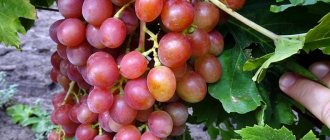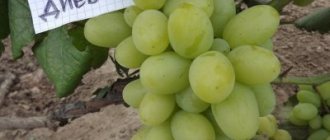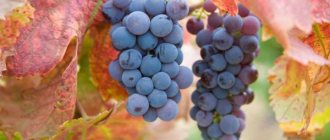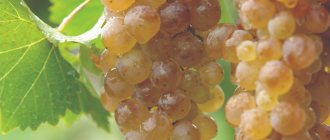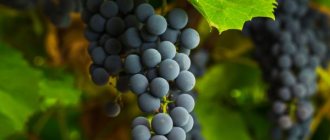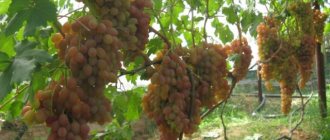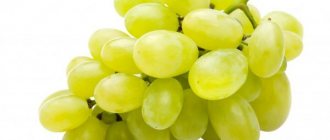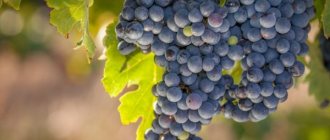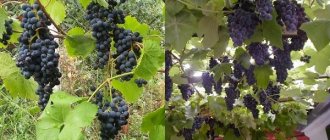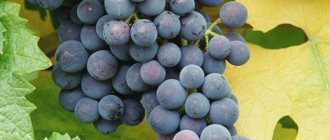Ruby, agrotechnical variety, medium ripening.
Bushes of medium height, with medium, strongly divided, five-lobed, non-hairy leaves. The surface of the leaf is smooth and saucer-shaped. The cutting pocket is open. Flowers of both sexes. The brushes are medium, dense, like a cone. The berry is small, round, black in color, heavily covered with a waxy coating, juicy, pleasant to the taste, with a tight peel. During the ripening process, ruby gains 23-25% sugar; in very hot weather, sugar can reach 30%. The shoots grow quickly and the harvest is large. Mold resistant. Chubuki take root well and quickly take root. The main advantage of grapes is their short life span, which allows them to be grown in cool areas. The reason is simple: he ripens quite early. The optimal place for its cultivation is the slopes of hills. The berries are practically not subject to rot and cracking, making its cultivation easy and inexpensive. Ruby grapes are used in the production of high-quality red wines. The taste of the wine is harmonious and captivating. The Rubin grape variety is divided into several types:
Description of the variety
Holodriga ruby is a variety used for wine production. Gained wide popularity due to the rapid growth of bushes and high yields. It was developed by the Ukrainian scientist Pavel Yakovlevich Golodriga and named after him. The breeder developed more than 40 varieties of grapes, and after the tragic death of a scientific colleague, a new grape variety was developed in 2008, which was named In Memory of Golodriga.
The variety in question belongs to the universal variety, bred by crossing the Koroleva species and the Magaracha variety. Popular among table wine producers. One of the main advantages of Rubin Golodriga bushes is the ability to grow grapes in almost all regions with a cool climate.
Bushes
The grapes have bushes of medium vigor, resistant to diseases and low temperatures. Their growth directly depends on proper care, feeding and living conditions. A distinctive feature from other types of grapes is the ability of the bushes to reach a height of up to 3 m. The leaves are round, with a bright green tint, and of medium size. The skin of the bushes is thin but durable. With proper care, large bushes can be grown in temperate climates.
Did you know? Legends of the ancient Russian people indicate that the grapevine was the forbidden tree in paradise.
Fruit characteristics
With careful care, grape bunches form large, the weight of each can reach 350 g. The berries are round, medium in size, weighing up to 5 g, dark brown-red in color. This shade is obtained due to a waxy coating that covers the skin of the berries; under proper lighting, they sometimes appear blue. The seeds are small and easily separated from the juicy pulp.
The fruits are characterized by sugar content up to 24%, acidity up to 11 g per 1 liter of juice, which makes it possible to produce high-quality rich and tasty wine. Experienced tasters assessed the taste of the berries, giving an average rating of 8 points on a ten-point scale. The berries have a persistent nightshade flavor.
Fruit ripening time and yield
On average, berries become ripe 121 days after the first buds open. The flower is bisexual and quickly pollinated. The main factors in achieving high yields of such grapes are careful selection of climatic conditions and planting location. Unlike most grape varieties, Golodrigi varieties tolerate low temperatures.
But still, the southern side of the buildings is considered to be the correct place to plant seedlings. Thanks to this choice, the grapes will be able to receive heat from the walls, and the berries will ripen 10-15 days earlier. If you plant grapes near buildings, you should retreat a few meters from the wall so that the rhizome does not have the opportunity to affect the foundation.
Important! Seedlings cannot be planted in the shade; trees should be at a distance of 3 m.
An important feature of grapes is that in the absence of proper maintenance conditions, the fruits may not ripen on time, but a little later, so you should not harvest the crop immediately after the expiration of the period. The berries are strong and do not fall off the bunches; it is possible to leave them to ripen until the first frost.
Thus, the grapes turn out to be exceptionally sweet, since by the end of September they tend to completely lose acid. Golodriga ruby produces voluminous harvests - up to 150 centners of harvest are harvested from 1 hectare during industrial cultivation.
Disease resistance and frost resistance
The variety adapts well to cold conditions; its ability to tolerate diseases allows it to quickly adapt to any soil. Holodriga ruby is resistant to mildew, phylloxera, oidium, rot, even in conditions of prolonged rain in cool climates. The variety is suitable for cultivation in winter, with sudden temperature changes. The vine survives frost down to –26°C.
Memory of Golodriga
This grape variety is relatively young, since it was bred only in 2008. They crossed the grapes Jalit and Anthea Magaracha for him. The grapes are grown exclusively for industrial use and are also protected by a patent. That is why it is difficult to find any details about this variety.
The grapes ripen late, and their distinctiveness lies in the fact that the juice has an intense color. In addition, it has all the characteristics typical of the species bred by the selector Golodriga. Golodriga's memory at the genetic level resists fungi, diseases and cold. The sugar content of large berries reaches 29%.
Advantages and disadvantages of the Ruby Golodrigi variety
The wort yield during processing of the variety is about 75%. When producing wine, you can get the unique taste of dry red wine in oak barrels, so its popularity is justified and has its fans. The main advantages of grapes are their high yield and resistance to diseases, which allows them to be grown in large volumes. The disadvantages include the late ripening period and the small size of the berries.
However, people have not forgotten Golodriga!
Wines are produced in memory of this outstanding scientist, here are just two reviews:
The wine is red from the 2021 vintage. Its price is quite affordable - a little more than 300 rubles. I especially like the inscription indicating the field number and the number of bottles produced from these grapes. More details on Otzovik: https://otzovik.com/review_7350969.html
Review of wine Yubileiny Winery Rubin Golodrigi Select 2021 03/15/2019 Dry red. 2021. Russia, region - Krasnodar region (Temryuk district, Yubileiny Winery LLC). Grapes: Rubin Golodrigi (obtained by crossing the Ruby Magaracha and Magaracha 6-68-27 varieties). Aroma: barely noticeable shades of dark plum jam, lightest notes of overripe cherries, lightest caramel tones, barely noticeable floral nuances, barely noticeable notes of vanilla. Taste: medium-tasting, well-balanced, barely noticeable tones of dark plum skins, light shades of ripe cherries, barely noticeable nuances of red berries, medium astringency, too “piercing” sourness, barely noticeable minerality, light herbaceous tones, barely noticeable bitterness, barely noticeable hints of pepper . Can be drunk with powerfully flavored red meat (including from the grill), savory poultry dishes, semi-hard and hard aged cheeses, powerfully flavored pates and salads, savory meats - lasagna, pasta and pizza.
Caring for Ruby Golodrigi grapes
In order for Ruby Golodrigi to take root on the site, it is recommended to water it intensively in the first year. During the rainy season, it is necessary to water the bushes 14 days after the end of the rains, and during drought - after 10 days. Dynamic watering is also carried out in mid-August, during the summer. Next, the vine needs to go through the ripening process, and fruiting will largely depend on proper pruning.
Important! The vine needs staking. Wire is used for these purposes.
Pruning is carried out in early spring, at a time when thunderstorms and severe frosts give way to warm weather. Pruning is completed before the sap flows, and one-year shoots are removed.
Watering
It is necessary to water the grapes, avoiding excess water, which negatively affects the yield level. Intensive watering is recommended more often in the spring, when the air temperature does not fall below 0°C. During periods of low temperatures, grapes are not watered because the water begins to freeze, and this leads to the death of the bush. After pruning, watering is resumed in the following volume: 30 liters of water per 1 m².
Feeding
In order for the variety to grow and develop, it must be fed. Once a year, the soil is fertilized with mineral fertilizers, and once every three years, organic matter is used when fertilizing. When the grapes are in the flowering period, they can be fed with superphosphate and potassium salt. During watering, the soil needs compost, humus and peat.
Find out how to properly feed grapes in the fall.
Preparing the plant for winter
Despite their high resistance to cold, it is recommended to wrap grape bushes in linen before a sharp drop in temperature. The bushes are divided into two parts, each of which is covered with canvas and placed on the ground. It is recommended to install metal arcs over the plant, which are covered with one layer of film. The film should not touch the branches, as this may damage the integrity of the vine bark.
Grapes Ruby Jubilee
Ruby Jubilee, medium ripening variety, final ripening occurs after the tenth of August. The berries are large and can withstand long-term storage. The vine is medium to tall and the trunk is impressive and strong. The clusters are large, weighing from six hundred to eight hundred grams. In shape, the clusters resemble a cylinder, with a conical base. The clusters can be left on the bush for a long time. Brushes remain on the bush for a long time. The berries are oval in the shape of a cylinder, each weighing about twelve grams. The color is dark, pink. Pleasant to the taste, with a thin peel. Flowers of both sexes tend to be pollinated in any weather. Shoot growth is normal, fruitfulness is high. Chubuki take root well, but in the first time after planting, they require abundant watering. Disease resistance has not been fully studied. There is no data on frost resistance.
Prevention of pests and diseases
Holodriga ruby copes with diseases and pests, but to avoid exceptions, it is necessary to care for the plant. Gardeners know that periodically it is necessary to pay attention to the presence of spots on the leaves or plaque. Yellow spots or plaque are the first sign that the plant has become infected with oidium or mildew, therefore, as preventive measures, it is recommended to treat the bushes with fungicides or Bordeaux mixture (1%) before flowering.
Did you know? To make one bottle of wine, you will need to use about 600 grapes.
Despite the fact that the variety is rarely attacked by pests, wasp attacks are possible, and sometimes birds can peck the berries. To prevent such situations from arising, it is recommended to fence the bunches with a special net. Holodriga Ruby is a wonderful variety to grow. To get the best possible harvest, you should study the rules and recommendations that are described in the article, and every gardener will be able to get sweet grapes for the production of wine products.
How and when to plant grapes in spring - Planting time, Selection of seedlings, Grape care
Collapse and its children
In 1985, 30% of the vineyards were destroyed, compared to 22% during World War II. Unique collectible grape varieties, such as Ekim-Kara, a component of the famous Black Doctor wine in Soviet times, were destroyed.
Stores sold alcohol from 14.00 to 19.00.
At six in the morning the rooster crows, at eight - Pugachev's, the store is closed until two, Gorbachev has the key.
And there was a continuation:
For a week, until the second, we’ll bury Gorbachev. If we dig up Brezhnev, we’ll drink as before.
The famous wine was saved from destruction by the intervention of Vladimir Shcherbitsky and the first secretary of the Crimean regional party committee, Makarenko. Active promoters of the anti-alcohol campaign were the secretaries of the CPSU Central Committee Yegor Ligachev and Mikhail Solomentsev, who insisted on the destruction of the vineyards. While on vacation in Crimea, Yegor Kuzmich was taken to Massandra. There, samples of produced wines are stored there for the entire 150 years of the famous plant’s existence - a wine library. All famous wineries in the world have similar storage facilities.
But Ligachev said: “This wine library must be destroyed, and Massandra must be closed!”
Vladimir Shcherbitsky could not stand it and called Gorbachev directly, saying that this was already an excess, and not a fight against drunkenness. Mikhail Sergeevich said: “Okay, save it.”
Golodriga tried to convince Gorbachev to cancel the destruction of the vineyards, but he was not heard... On December 19, 1986, the academician committed suicide.
Reviews
Hello! I have been growing this variety Ruby Golodrigi for 3 years. This year I collected the first harvest from which I make wine. In my conditions - the northern part of the Nikolaev region, the variety showed some qualities that were different from the description on the website. First, the growth force on chernozems is quite strong. Regarding taste, nightshade tastes amazing! The sugar content is also decent - this year I harvested it at 22 - 23% Brix. It lost acidity somehow quickly - on September 20 the acid was still felt in the taste, but on September 27 it was no longer there. The color of the wort is intense ruby. Regarding agricultural cultivation techniques, after daily rainfalls with cool weather, signs of mildew damage appeared. I would like to note that for personal reasons it was not possible to treat quickly, but I did not observe intensive development of the disease after a week, i.e. the variety “resists” the development of fungal disease well (unlike other varieties). During harvesting, I did not find any berries affected by gray rot. In principle, if the variety does not have time to ripen, you can try not to rush into harvesting, but remove it after the first frost (it will not rot). The vine ripens quite well. The variety also has such a positive trait as late blooming of the eyes. This year, on my site, 2 varieties were not damaged by spring frosts - Ruby Golodrigi and Moldova.
Andrew
https://forum.vinograd.info/showpost.php?p=81687&postcount=1
Forum statistics
207033 Messages in 1634 Topics from 5593 Users. Latest user: Amaya Latest message: “Ripening dates are different...” ( Today at 00:37:47 ) Latest messages on the forum.
Now on the forum
38 Guests, 4 Users
Users in the last 15 minutes: hanter64, znakomij, Alexander K, Vardan [Blocked] [Section Moderator] [Forum Moderator]
Maximum online today: 77 . All-time maximum online: 2758 (28 July 2021, 17:22:51)
Users who visited the forum in the last 24 hours
Total: 300
(Visible: 299, Hidden: 1) 1963, hanter64, znakomij, Alexander K, Vardan, Sergey Fer, Anatoly Sivkov, yotmast, Alexey V, Ilya 77, Andrey gladilin, Tatyana A., Belgorodets, in Astrakhan, Oksana Kopp, Tatyana B, sem_en, Alex65, Vladimir 153, skier, Igor Viktorovich, slavalimon, Alexander Vl., Primorets, OlgaOs, SANYCH, 31rus, mystic69, DorontsovPeter, Andrey Tsvetkov, Buba, Cherkessk, igor222, Andrey76, Elena Z, vlad51, Kenig, Nikolay Rex, Sergey 1965, Vladimir Buturlakin, DSW, psv1960, Dmitry 77, Vasily V., Vyacheslav03, Natalia Nikolaevna, Sergey Tashchiyan, Nikolay S., Igor Sergeevich, alexsandr, kvg, Pioneer, Ekaterina Polyanina, nicson7, Elena Aleshchenko, Alexander -ask-34, Verona, Igor F., Taker, Tikhy, Henry, Yuri72, L.A.P., Gaivoronsky Yuri, Sergeevich, Sergey Chistokletov, Svetlana Streletskaya, Galinka, Alexey Deminov, Naumov Igor, Vyacheslav136, Gloomy, Katrin , AndSanych, vladimirM, Mikhno Alexander, Ded31, Filippov Oleg, Vladimir ++, Svetla777, Mikhail Alekseevich, Lydia58, Mikhail77, ALEXANDER BRYANSKY, Vladimir-kanevskaya, leonidych, DIL, Amber7394, Marina Protasova, TITOVA LYUBOV, Linx, alexander66, Natalya M, Mikhail Fesenko, ElenkaF, Amaya, Alexander71, Boris 1952, tsv, Maximilian, 25nata35, nadia, GALINA ANOKHINA, Igor_K, Alexander Kolesnikov, Ivan Levin, Pitko, weather forecaster, eSAa, cecet71, atseton, Alexander Smirnov, Vladimir Kostochkin, Vladimir Berdnikov, Gocha, pioneer-2, mers, LeXa_KoT, Sergey 61, Sergey Yuryev, Erem, alexss, Evgeniy52, Skif, lomakin1969, Vladimir Kovba, dayton, Yuri Semyonov, N.A. Sokolov, Pavlentiy, Sa-shura, Volgogradka, Dmitry Anatolyevich, Grandfather Igor, Andrey Lis, Bublichenko Alexander M, Marina Krymskaya, stenlly2010, irahelm, Vyacheslav Vladimirovich, Vladimir Shilov, Aprel, Dmitry Badaev, gheo55, Yura, y_fed, rambo, Yagodka, Valentina Ivanovna, Kryn, oleg9f, DED2, Korotina Svetlana, Delivered Oleg Ivanovich, Eduard., santra, L2k2m7n, Alexander48, Viknik, Andrey 31, m2d, Marshal, Valery Rastorguev, Serg1707, Soshnin Yura, Amateur gardener, Galina, Vasily1111, gardener, marlin64, Salex, sergei, Sergey Ko, Ramiz, victor_, kosmos, potap05, Yuri 36, VitaliySD, Inna161, Vova Kapran, Vladimir Shcherbinin, Valerie, niy1, cfibr, Andrey68, Elvira2017, kulol3, Slavka, thanatos, Serzh1978, Realist, Artur53, max2008-01, LOZA , AlexanderD, Grandfather Young, Natasha, Zayac, ketch, Rita, alx-74, Iv Iv, Alexander150, Igor K, SNovichek, Vasily Viktorovich, VeraNiK, kdm57, Veniaminovich, Boris Sokolyansky, therapist, Capricorn, 77volt, , vikbublik, neposny , Evgen, Victoria Aleksandrovna, Serezha 64, Wintel, Airbone, teri, Sergey Lomonosov, Khramov, serginio, Leonty Yarygin, Irina O., Ser, Nadezhda Grig, zsb, Lyubov S., netolya, Saisan, Agryzkov Alexey, Vadi, Zinaida , Vadim, Alexander Taganrog, Sukhonon Sergey, Snezhinets, Evgen_26, NAU_63, Masha_Sadovod, Gennady163, Krasnovlad1, Alexander Zinoviev, Vasily 53, Roman Fedorovich, Tis, Alexey Sergeyevich, Arnya, Zhek, Nurtas, Kradievska, 64nikolay64, Nick041, Li, Nick041, Li, Nick041, Li, Nick041, Li ZA, Valentine Medvedeva, Sergey43, Andrey S., Nikolay Lipunov, Mst, Vertuoz2, Vladimir VS, NatalyaMed, freesia, Kinna, Mikhail Michurinsk, alekcsan1, VALERY TAMB, Sasha57, MikhAf, Y_Azer, Andrey Beribesov, hunter1955, nut lover, Keys, Ivan Shmelev , Pestle, anton_slash, Nadymchanka, Sergey 31, Volgar, Pavel 64, Tatyana Volzh, Elektronik_t, Alexander 61, spotlight, Alexander Gai, Cheprak, Pirko Alexander, vladimirvrn, Antrikan, asun16, Alexey Viktorovich, YurSanych, bairina, Lekseich
Characteristics
The variety is strong and unbending, as it should be a symbol of true love. He is not afraid of powdery mildew - oidium and mildew, or various types of rot, or other bacterial diseases of grapes.
True, it is not very resistant to wasps. The yield of the variety is high, it needs to be rationed with eyes and shoots. Trim to six to eight eyes, leaving the norm at 35 per bush.
It requires mandatory shelter for the winter, since the maximum permissible “minus” for Ruby is 22 degrees Celsius. Afraid of rain.
In unfavorable years, the flowers fall off greatly. The ripening of the vine is almost the entire length of the growth. The percentage of sugar content is up to 20 Brix.
Vodograi, Tien Shan and Rozmus also prefer to spend the winter in shelter.
Growing Muscat grapes Summer
This is one of the few garden crops that are valued not only for their high-quality and healthy fruits, but also for their attractive, aesthetic appearance. The Muscat grape variety occupies a special place among varietal plants. Most winegrowers want to see it on their plot. In addition to its many positive qualities, this variety has amazing unpretentiousness to conditions.
Varietal characteristics
According to the description, the summer Muscat grape is a bush that is distinguished by its size - its height can reach 3 m. A characteristic feature of the varietal crop is a large number of fruitful shoots.
Muscat's clusters are voluminous, but not dense, and have an elongated shape. The weight of one copy can reach 1 kg. Description of berries: oval shape, large size. The color of the fruit depends on the place of cultivation: in the sun they will have an amber color, in the shade they will be almost white.
Grapes have thick skin, rich and dense, juicy pulp. The taste of the berries depends on the soil and growing region.
- The description suggests that the summer Muscat grape variety is an early ripening grape variety; its commercial maturity occurs 4 months after the appearance of the first ovary. With proper care, you can enjoy the berries in August and early September.
- The variety takes root well and quickly in a new place. The vine of an adult plant ripens evenly and en masse.
- Muscat grape varieties are distinguished by their high yield. The crop is grown on an industrial scale. From one bush in your summer cottage you can collect up to 40 kg of ripe, aromatic berries.
- Despite the fact that the varietal crop characterizes itself as frost-resistant (the plant can withstand temperatures down to -27°C), in more severe regions it requires insulation for the winter.
- Muscat is highly resistant to most diseases and can withstand temperature changes without damaging the crop.
- It can be transported, but after the fruit has been removed from the vine, it is stored for a short time.
Landing
If planting rules are followed, a varietal summer crop can adapt to new conditions in the shortest possible time. This will make it possible to annually obtain a bountiful harvest of quality berries.
Growing methods
The Muscat variety, like similar crops, can be planted in the following ways:
- seedlings;
- by grafting a sprout onto an adult plant.
In the second case, the plant quickly takes root and will be able to bear fruit earlier than the seedling.
Grape planting material should be purchased from specialized stores, which are responsible for the grade of the crop and proper preparation.
When choosing a varietal summer plant, it is recommended to pay special attention to its appearance. The seedling must have a healthy root system, without visible damage or signs of disease.
Boarding time
It is recommended to plant the crop in spring or autumn. It is important to take into account the climate zone and its characteristic weather conditions.
The graft can be done at any time of the year, before the onset of cold weather.
It is recommended to plant young seedlings when the air temperature is at least +15°C. This will enable the plant to take root as quickly as possible, subject to simple agrotechnical rules.
Care
In order for Muscat to bear fruit well and regularly, it is recommended to follow the basic rules of cultivation. It is better to make a place for planting the plant in advance - in the fall.
At the bottom of the hole you can lay a small layer of fertile soil or rotted humus.
- It is advisable to grow grapes on fertile black soil, moderately moist. Excess moisture in the soil can provoke rapid rotting of the root system of a grape seedling, as well as the spread of viral and bacterial diseases in it.
- The area for growing grapes should be well illuminated by sunlight and be closed from drafts.
- The distance between the bushes should be at least 1.5 m. This way the plants can develop qualitatively without interfering with each other.
- The young seedling should be placed in the prepared hole carefully, without damaging the root system. Depending on the size of the planting material, the hole should be so deep that the neck of the root, after filling the hole, is 10-15 cm above the soil surface.
- It is recommended to fill the hole with a layer of fertile soil mixed with organic materials (humus, peat). It should be borne in mind that grapes do not accept nitrogenous soil.
- Having filled the place where the crop is planted, you should compact the soil a little in this place and generously water the young bush with cool water. It is better to plant in the evening or cloudy times. Subsequent watering of young grapes is recommended to be done after sunset or early in the morning.
- After planting, it is advisable to tie the seedling to a support previously equipped next to the bush.
- Autumn planting involves subsequent warming of the root system and trunk of the crop. This can be done using mulching materials - peat, straw, fallen leaves, special insulating film.
- Additional fertilizing of the varietal crop will make it possible to obtain a rich harvest. Rotted humus, complex mineral and organic fertilizers, and potassium phosphate substances are used as fertilizers.
- Systematic loosening of the soil around the grape trunk will not only get rid of weeds, but will also allow oxygen to freely flow to the root system of the plant, retaining moisture in the soil for a longer time.
Hybrids of Soviet selection from “Yubileinaya”
On March 2, 2021, the Yubileiny winery and winery held a tasting of wines from the Select line, consisting of hybrids of the old Soviet selection. Among the positive aspects, I would like to note the invaluable experience of tasting rare hybrid varieties, the wines of which are mainly made by amateur winemakers on their plots, and almost no one produces commercial copies. Some questions and bewilderment were caused, firstly, by the too “perfume” style, but it clearly has its fans, and, secondly, by the fact that the taste does not continue the aroma, but lies in a parallel plane that does not intersect with the aromatics in any way . Of the 2,500 hectares of vineyards owned by Yubileiny, hybrids occupy 30%, so the farm will struggle, adapt and look for better methods of working with them. Moreover, thanks to their frost resistance, these varieties are “lifesavers” in cold years. Consequently, we will have the opportunity to follow the developments of events, so we need to get to know the “strangers” of the Soviet selection better.
While Soviet ships roamed space, Soviet scientists worked in laboratories, developing new varieties of grapes that would increase yields and be resistant to frost and disease. Of course, we were talking about the quality of planting material, but only in terms of the minimum costs for processing the vineyards. Most Soviet works do not mention the organoleptic properties of new varieties, so it is difficult to say whether attention was paid to this.
The famous geneticist A.M. Negrul divides hybrids into two types. The first group includes hybrids obtained by crossing two different varieties belonging to the same species, the so-called intraspecific hybridization
.
Crossing plants of two different species is called interspecific hybridization
. It is usually used to breed varieties that are resistant to frost and disease. It often turned out that the result was that the wild parent was dominant, i.e. the vine was strong and healthy, but the quality of the grapes left much to be desired.
To understand the issue, let’s briefly touch on the classification of the Grape family ( Vitaceae
), which consists of 12 genera.
Of key importance is the genus Vitis
, whose representatives are divided into three geographical groups:
I. European-Asian
This group includes 1 species -
Vitis Vinifera
, which consists of two subspecies - wild (Vitis vinifera silvestris) and cultivated (Vitis vinifera sativa).
II. East Asian
This group includes about 40 species, of which the most famous and widespread is the Amur grape (
Vitis amurensis
).
III. North American
It consists of 28 species, the most famous of them are
Vitis rupestris, Vitis riparia, Vitis labrusca
.
During the Soviet years, the monumental work “Ampelography of the USSR” was published, in which various varieties of grapes discovered during expeditions were collected. One of the oldest and largest enterprises is the All-Union Research Institute of Winemaking and Viticulture "Magarach"
in Crimea, whose history began in 1828. Today, the ampelographic collection of the institute contains more than 4 thousand samples, but “Magarach” not only maintained the fund, but was always actively involved in breeding new varieties. Starting from the 1930s, work was carried out on intervarietal hybridization, during which Bastardo Magarachsky, Ruby Magaracha, Early Magaracha and others appeared. In the 1950-60s. the school of the outstanding scientist P.Ya. was formed. Golodrigi, who made a huge contribution to breeding research.
Pavel Yakovlevich Golodriga was the director of the All-Russian Scientific Research Institute "Magaracha" and was in charge of the grape breeding department. According to the recollections of his contemporaries, he was very passionate about his business, and resigned from the position of director when the head of the USSR Glavvino L.F. Shaituro transferred all the vineyards to wide-row formations and committed suicide in 1986, when the vineyards began to be uprooted during the anti-alcohol campaign. Golodriga supported chemical methods of controlling phylloxera using carbon disulfide. But the USSR followed the European path, starting to use grafted vines. Pavel Yakovlevich also worked a lot with new hybrid varieties that would be resistant to diseases and pests. A special place in his scientific activity was occupied by the search for the “ideal grape variety.” Golodriga and his students created 50 new varieties, the most famous of which are Firstborn of Magaracha, Gift of Magaracha, Aurora Magaracha, Danko.
Magarach's firstborn
– a white grape variety obtained by crossing the Rkatsiteli variety and the hybrid form Magarach 2-57-72.
The firstborn of Magarach is one of the ten most common varieties in our country. The aroma features rose petals and candy notes, good acidity and a citrus finish. Rubin Golodriga
is a red grape variety obtained in 1974 as a result of the hybridization of Ruby Magaracha (Cabernet Sauvignon x Saperavi) and Magarach 6-68-27 (a direct producer hybrid of Rava Blanc (aka Zeibel 5474) x Asian Pollen). Quite sharp in both aroma and taste, with a predominance of cherry tones.
— We carry out malolactic fermentation for hybrid varieties such as Rubin Golodrigi and Amur Potapenko using our own bacteria, which are found in the skin of the grapes, —
says Sergey Dubovik, general director and chief oenologist of the Yubileiny winery,
“fermentation is difficult, sometimes for two or three months. Golodriga ruby is a complex variety; at first, our wine turned out damp and hollow. It took two years to understand how to work with it correctly.
Variety Viorica
was bred in 1969 in Moldova by crossing the varieties Zeibel 13-666 (direct producer hybrid) and Aleatico.
The advantage of this variety is its excellent frost resistance, which makes it possible not to cover the vines in winter, even if the temperature drops below 25 degrees. Viorica belongs to the group of varieties with muscat aromas. I would like to dwell a little on one of Viorica’s parents - Zeibel
, who is part of a hybrid group of direct sires, i.e. grape varieties created by man by crossing American grape varieties and European varieties in order to obtain forms that are more resistant to phylloxera. The French scientist Seibel took the European grape varieties Aramon and Alicante Boucher as parent pairs and crossed them with the “Americans”.
Citron Tsyurupinsky
obtained by crossing the Don variety Pukhlyakovsky with hybrids by scientists from the Nizhnedneprovsky NIISOP. It is distinguished by aromas of lemon wedges, spices and roses, vaguely reminiscent of the aromas of Gewürztraminer.
Another white variety presented at the tasting is Crystal
, is an interspecific hybrid obtained by breeders from Hungary as a result of crossing (Amursky x Chalotsi Lajos) x Villar Blanc.
Amursky Potapenko stands a little to the side
, obtained by crossing Amur wild grapes (Vitis amurensis). It is believed that this is the most frost-resistant variety, withstanding temperatures below minus 30 degrees. The work with Amur grapes was carried out by biologist-breeder A.I. Potapenko, brother of the famous scientist Ya.I. Potapenko. Alexander Ivanovich set the task of developing grapes that would be resistant to diseases. Many years were spent searching and researching, and as a result, the Amur Potapenko family of hybrids appeared, which resisted fungal diseases and could grow in unfavorable conditions where other varieties would not survive. Amur Potapenko is not widely used, perhaps because it is intended for regions where viticulture is not developed. Amur Potapenko from Yubileiny has a signature aroma of peonies, which clearly manifests itself in the glass.
From the north we move to the south to get acquainted with the “pet” of the Anapa zonal experimental station of viticulture and winemaking, which appeared on the basis of the former Kuban Cossack experimental field in 1922, and now bears the name Ya.I. Potapenko. Decent was presented at the tasting
, obtained by crossing the Phylloxera-resistant varieties “Dzhemete” and Hamburg Muscat (Alexandrian Muscat x Frankenthal). In general, there is some kind of detective story going on with the Phylloxera-resistant Dzhemete. It seems that Anapa ZOSViV relied on this variety, at least they conducted experiments during which they crossed the Phylloxera-resistant “Dzhemete” with 16 different grape varieties, both red and white. The goal was to obtain varieties resistant to phylloxera. As a result, 16 technical varieties were obtained, among them Dostoyny. At the same time, it was not possible to find out who the parents of the phylloxera-resistant “Dzhemete” are, although there are vague mentions that it is from the genus Vitis vinifera, which is not resistant to phylloxera. In the Anapa ampelographic collection it is written so simply: the origin is unknown. Therefore, it is not 100% clear whether Worthy is an interspecific or intervarietal hybrid.
Two varieties at the tasting were obtained at the Research Institute named after. Tairova (Odessa), which was founded in 1905 in the Russian Empire as a wine-making station. Varieties such as Tairovsky, Rubin Ukrainy, 40 Let Oktyabrya, Golubok, Sukholimansky White, Odessky Black and others were created here.
Red variety 40 years of October
is a hybrid of the autochthonous Moldavian variety Kopchak and Alicante Boucher. What is surprising (or logical) in this story is that Kopchak was considered a very promising variety, but when new, more productive ones began to appear, everyone was chasing quantity. Kopchak was present for a long time in the old large collection of the institute, and in the 80s. during replanting, a number of varieties were rejected, including Kopchak. Synonymous with 40 Years of October is the name Cherry, which to some extent reflects the aroma in which cherry-chocolate, slightly spicy notes can be discerned.
The most controversial and characteristic variety turned out to be Golubok
– an interspecific hybrid (Vitis vinifera L x Vitis amurensis Rupr.), obtained as a result of pollination of the Severny variety with a mixture of pollen from the varieties 40 let Oktyabrya, Odessky early and form 1-17-54 (Alicante Boucher x Cabernet Sauvignon). Its smoky, sulphurous, slightly rotten aromas can either attract or repel.
We also thank the Yubileiny winery for the tasting!
Another white variety presented at the tasting is Crystal
, is an interspecific hybrid obtained by breeders from Hungary as a result of crossing (Amursky x Chalotsi Lajos) x Villar Blanc.

